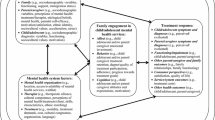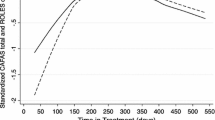Abstract
Background
Family involvement is viewed as an important component of the treatment process for children in residential treatment centers, but little is known about the impact of contact with family members on changes in youth functioning.
Objective
The goal of this study was to use administrative data to examine the association between family involvement and youth outcomes for a Medicaid-funded residential treatment program in Florida. Differences between in-person and telephone intervention contacts based on the proximity of the family residence to the program were also explored.
Methods
The sample was divided into two groups based on the number of family contacts per month during the treatment episode; i.e., number of family contacts equal to or less than the median and number of family contacts greater than the median. Generalized estimating equations were used to examine characteristics related to the percent change in scores on a measure of emotional and behavioral functioning.
Results
Results suggest that maternal and paternal contacts, as well as the total number of family contacts, were associated with greater improvements in youth functioning. Youth that resided in a different county than the residential program had greater improvement in behaviors when the family was involved regardless of whether contact was in-person or over the phone.
Conclusions
Family involvement, including phone contacts, is associated with improved youth outcomes during the treatment episode.
Similar content being viewed by others
References
Achenbach, T. (1991). Manual for the child behavior checklist/4-18 and 1991 profile. Burlington, VT: University of Vermont Department of Psychiatry.
Affronti, M. L., & Levinson-Johnson, J. (2009). The future of family engagement in residential care settings. Residential Treatment for Children & Youth, 26, 257–304.
American Association of Children’s Residential Centers. (2005). Redefining residential: One through eight. Retrieved from http://www.thinkkids.org/docs/Redefining.pdf.
Antonucci, T. C., Akiyama, H., & Takahashi, K. (2004). Attachment and close relationships across the life span. Attachment and Human Development, 6, 353–370.
Armstrong, M., Dollard, N., Robst, J., Hummer, V., Li, W., Cobb, S., et al. (2010). Evaluation of Medicaid-funded out-of-home alternatives for FY 09–10. Tampa, FL: Louis de la Parte Florida Mental Health Institute, University of South Florida.
Baker, B. L., & Blacher, J. (2002). For better or worse? Impact of residential placement on families. Mental Retardation, 40, 1–13.
Baker, B. L., Blacher, J., & Pfeiffer, S. (1993). Family involvement in residential treatment of children with psychiatric disorder and mental retardation. Hospital & Community Psychiatry, 44, 561–566.
Blader, J. C. (2004). Symptom, family, and service predictors of children’s psychiatric rehospitalization within one year of discharge. Journal of the American Academy of Child and Adolescent Psychiatry, 43, 440–451.
Blau, G. M., Caldwell, B., Fisher, S. K., Kuppinger, A., Levison-Johnson, J., & Lieberman, R. (2010). The building bridges initiative: Residential and community-based providers, family, and youth coming together to improve outcomes. Child Welfare, 89(2), 21–38.
Bowlby, J. (1969/1982). Attachment and loss. New York, Basic Books.
Child Welfare League of America, Inc. (2004). CWLA standards of excellence for residential services. Washington, DC: Author.
Frensch, K. M., & Cameron, G. (2002). Treatment of choice or a last resort? A review of residential mental health placements for children and youth. Child & Youth Care Forum, 31, 307–339.
Gorske, T. T., Srebalus, D. J., & Walls, R. T. (2003). Adolescents in residential centers: Characteristics and treatment outcomes. Children and Youth Services Review, 25(4), 317–326.
Greenbaum, P. E., & Dedrick, R. F. (1998). Hierarchical confirmatory factor analysis of the Child Behavior Checklist/4-18. Psychological Assessment, 10, 149–155.
Hair, H. J. (2005). Outcomes for children and adolescents after residential treatment: A review of research from 1993 to 2003. Journal of Child and Family Studies, 14(4), 551–575.
Hardin, J., & Hilbe, J. (2002). Generalized estimating equations. Danvers, MA: CRC Press.
Hoagwood, K., Burns, B. J., Kiser, L., Ringeisen, H., & Schoenwald, S. K. (2001). Evidence-based practice in child and adolescent mental health services. Psychiatric Services, 52, 1179–1189.
Jenson, J. M., & Whittaker, J. K. (1987). Parental involvement in children’s residential treatment. Children and Youth Services Review, 9, 81–100.
Kahn, R. L., & Antonucci, T. C. (1980). Convoys over the life course: Attachment, roles, and social support. In P. B. Baltes & O. G. Brim (Eds.), Life-span development and behavior (Vol. 3, pp. 253–286). New York, NY: Academic Press.
Kruzich, J. M., Jivanjee, P., Robinson, A., & Friesen, B. J. (2003). Family caregivers’ perceptions of barriers to and support of participation in their children’s out-of-home treatment. Psychiatric Services, 54, 1513–1518.
Lakin, B. L., Brambila, A. D., & Sigda, K. B. (2004). Parental involvement as a factor in the readmission to a residential treatment center. Residential Treatment for Children & Youth, 22(2), 37–52.
Leathers, S. J. (2002). Parental visiting and family reunification: Could inclusive practice make a difference? Child Welfare, 81, 595–616.
Lee, L. J. (2011). Adult visitation and permanency for children following residential treatment. Children and Youth Services Review, 33(7), 1288–1297.
Levitt, M. J., Levitt, J., Bustos, G. L., Crooks, N. A., Santos, J. D., Telan, P., et al. (2005). Patterns of social support in the middle childhood to early adolescent transition: Implications for adjustment. Social Development, 14, 398–420.
McWey, L. (2000). I promise to act better if you let me see my family: Attachment theory and foster care visitations. Journal of Family Social Work, 5, 91–105.
Stage, S. A. (1999). Predicting adolescents’ discharge status following residential treatment. Residential Treatment for Children and Youth, 16(3), 37–56.
Sunseri, P. A. (2001). The prediction of unplanned discharge from residential treatment. Child & Youth Care Forum, 30, 283–303.
Sunseri, P. A. (2004). Family functioning and residential treatment outcomes. Residential Treatment for Children and Youth, 22(1), 33–53.
Walter, U. M., & Petr, C. G. (2008). Family-centered residential treatment: Knowledge, research, and values converge. Residential Treatment for Children & Youth, 25(1), 1–16.
Wells, K., Wyatt, E., & Hobfoll, S. (1991). Factors associated with adaptation of youths discharged from residential treatment. Children and Youth Services Review, 13, 199–216.
Author information
Authors and Affiliations
Corresponding author
Rights and permissions
About this article
Cite this article
Robst, J., Rohrer, L., Armstrong, M. et al. Family Involvement and Changes in Child Behavior During Residential Mental Health Treatment. Child Youth Care Forum 42, 225–238 (2013). https://doi.org/10.1007/s10566-013-9201-6
Published:
Issue Date:
DOI: https://doi.org/10.1007/s10566-013-9201-6




